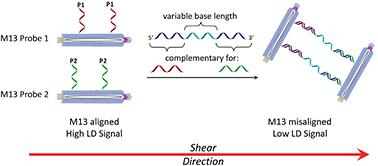当前位置:
X-MOL 学术
›
RSC Chem. Biol.
›
论文详情
Our official English website, www.x-mol.net, welcomes your feedback! (Note: you will need to create a separate account there.)
Combining bacteriophage engineering and linear dichroism spectroscopy to produce a DNA hybridisation assay
RSC Chemical Biology Pub Date : 2020-10-23 , DOI: 10.1039/d0cb00135j Aysha Ali 1, 2 , Haydn A Little 1 , Jake G Carter 1 , Craig Douglas 3 , Matthew R Hicks 4 , David M Kenyon 3 , Christophe Lacomme 3 , Richard T Logan 2 , Timothy R Dafforn 2 , James H R Tucker 1
RSC Chemical Biology Pub Date : 2020-10-23 , DOI: 10.1039/d0cb00135j Aysha Ali 1, 2 , Haydn A Little 1 , Jake G Carter 1 , Craig Douglas 3 , Matthew R Hicks 4 , David M Kenyon 3 , Christophe Lacomme 3 , Richard T Logan 2 , Timothy R Dafforn 2 , James H R Tucker 1
Affiliation

|
Nucleic acid detection is an important part of our bio-detection arsenal, with the COVID-19 pandemic clearly demonstrating the importance to healthcare of rapid and efficient detection of specific pathogenic sequences. As part of the drive to establish new DNA detection methodologies and signal read-outs, here we show how linear dichroism (LD) spectroscopy can be used to produce a rapid and modular detection system for detecting quantities of DNA from both bacterial and viral pathogens. The LD sensing method exploits changes in fluid alignment of bionanoparticles (bacteriophage M13) engineered with DNA stands covalently attached to their surfaces, with the read-out signal induced by the formation of complementary duplexes between DNA targets and two M13 bionanoparticles. This new sandwich assay can detect pathogenic material down to picomolar levels in under 1 minute without amplification, as demonstrated by the successful sensing of DNA sequences from a plant virus (Potato virus Y) and an ampicillin resistance gene, ampR.
中文翻译:

结合噬菌体工程和线性二色光谱来产生 DNA 杂交检测
核酸检测是我们生物检测库的重要组成部分,COVID-19 大流行清楚地证明了快速有效地检测特定致病序列对医疗保健的重要性。作为建立新的 DNA 检测方法和信号读出的驱动力的一部分,我们在这里展示了如何使用线性二色性 (LD) 光谱来生产快速和模块化的检测系统,用于检测来自细菌和病毒病原体的 DNA 数量。LD 传感方法利用了生物纳米颗粒(噬菌体 M13)的流体排列变化,DNA 支架共价连接到其表面,读出信号由 DNA 靶标和两个 M13 生物纳米颗粒之间互补双链体的形成引起。马铃薯病毒 Y ) 和氨苄青霉素抗性基因ampR。
更新日期:2020-11-03
中文翻译:

结合噬菌体工程和线性二色光谱来产生 DNA 杂交检测
核酸检测是我们生物检测库的重要组成部分,COVID-19 大流行清楚地证明了快速有效地检测特定致病序列对医疗保健的重要性。作为建立新的 DNA 检测方法和信号读出的驱动力的一部分,我们在这里展示了如何使用线性二色性 (LD) 光谱来生产快速和模块化的检测系统,用于检测来自细菌和病毒病原体的 DNA 数量。LD 传感方法利用了生物纳米颗粒(噬菌体 M13)的流体排列变化,DNA 支架共价连接到其表面,读出信号由 DNA 靶标和两个 M13 生物纳米颗粒之间互补双链体的形成引起。马铃薯病毒 Y ) 和氨苄青霉素抗性基因ampR。



























 京公网安备 11010802027423号
京公网安备 11010802027423号